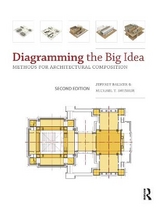
Diagramming the Big Idea
Routledge (Verlag)
978-0-415-89408-1 (ISBN)
- Titel erscheint in neuer Auflage
- Artikel merken
As you follow the development of the four project groups drawn from the authors’ teaching, you will become familiar with architectural composition concepts such as proportion, site, form, hierarchy and spatial construction. In addition, description and demonstration essays extend concepts to show you more examples of the methods used in the projects. Whether preparing for a desk critique, or any time when a fundamental insight can help to resolve a design problem, this new and expanded edition is your essential studio resource.
Jeffery Balmer is an assistant professor of architecture at the University of North Carolina at Charlotte. Michael T. Swisher is an associate professor of architecture at the University of North Carolina at Charlotte.
Acknowledgements Foreword 1. Introduction 1.1 Read Me First! 1.2 What is Architecture? 1.3 Organization, Order, Composition 1.4 Utility, Function, Purpose 1.5 Measure, Matter, Method 1.6 Design and Method 1.7 Method and Methodology 1.8 How This Book Works 1.9 Two Roles for Precedents 1.10 The Form of the Argument 1.11 Glossary 1.12 Description 1: Order and Measure 1.13 Demonstrations 2. Sorting Through Ideas 2.1 Diagrams as Method 2.2 Diagram Types 2.3 Diagram and Design Education 2.4 Learning Diagrammatic Form 2.5 Gestalt Sub-categories 2.6 The Diagram and Visual Order 2.7 Our Purpose 2.8 Glossary 2.9 Description 2: The Essential Hut 2.10 Demonstrations 3. Order First 3.1 On Order 3.2 On Measure 3.3 Dividing the Square 3.4 Rules of Engagement 3.5 Positive and Negative Space 3.6 Order and the Orthogonal 3.7 Glossary 3.8 Description 3: Order, Orientation and the Orthogonal 3.9 Demonstrations 4. Design and Drawing Fundamentals 4.1 On Drawing 4.2 Relevance to Design 4.3 Deriving Order in Drawing 4.4 Exercises in Relational Geometry 4.5 Defined and Implied Space 4.6 Analyzing the Composition 4.7 Three Variant Compositions 4.8 Contrast, Repetition, Alignment and Proximity 4.9 The Variations Considered 4.10 General Observations 4.11 Motif, Pattern and Theme 4.12 Defined Fields 4.13 Sorting Through Results 4.14 Implied Fields 4.15 Adding Fields 4.16 Combining Fields 4.17 Summary 4.18 Glossary 4.19 Description 4: The Courtyard 4.20 Demonstrations 5. Building on Proportion 5.1 Object on a Field 5.2 A figure in the Relational Field 5.3 Looking at the Groups 5.4 Adding to the Quadrants 5.5 Two Elements 5.6 Refining the Figures 5.7 Observing the New Figures 5.8 Observing the New Group 5.9 Glossary 5.10 Description 5: Figures and Fields 5.11 Demonstrations 6. Conventions in Design 6.1 Drawing in the Third Dimension 6.2 Adding Fields and Overhead Planes 6.3 Turning the Grid 6.4 Reading the Section 6.5 Plan Layers 6.6 Final Relief 6.7 Summary 6.8 Glossary 6.9 Description 6: Axis and Path 7. Starting in Three Dimensions 7.1 Design on a Grid 7.2 The Site 7.3 Three Figures 7.4 Spatial Models 7.5 Visualizing Axes 7.6 Spatial Hierarchy - Field, Grain and Path 7.7 Clarifying Plan Elements 7.8 More Complex Strategies 7.9 Diagram Model #1 7.10 Three Diagram Models 7.11 Five Diagrams 7.12 Constructing the Model 7.13 Glossary 7.14 Description 7: Spatial systems 8. Precedent in Two Dimensions 8.1 Introduction 8.2 Two Concepts 8.3 Two Expressions 8.4 Two Dimensions 8.5 House with Three Courts 8.6 The Danteum 8.7 Glossary 9. Precedents in Three Dimensions 9.1 Introduction 9.2 Representing the Third Dimension 9.3 Phillips Exeter Academy Library 9.4 Plan + Section = Isometric 9.5 Three-dimensional Anatomy 9.6 Unity Temple 9.7 Fundamental Diagrams 9.8 Cubes in Common 9.9 Diagram as Generator 9.10 Glossary 10. Color & Material in Diagrams 10.1 First observations 10.2 Initial Encounters 10.3 A first Visual Palette 10.4 Color and Materials 10.5 Color and Material as Identifiers in Diagrams 10.6 Glossary 10.7 Demonstration Appendices Glossary Sources Index
| Verlagsort | London |
|---|---|
| Sprache | englisch |
| Maße | 219 x 276 mm |
| Gewicht | 1157 g |
| Themenwelt | Technik ► Architektur |
| ISBN-10 | 0-415-89408-5 / 0415894085 |
| ISBN-13 | 978-0-415-89408-1 / 9780415894081 |
| Zustand | Neuware |
| Haben Sie eine Frage zum Produkt? |
aus dem Bereich



